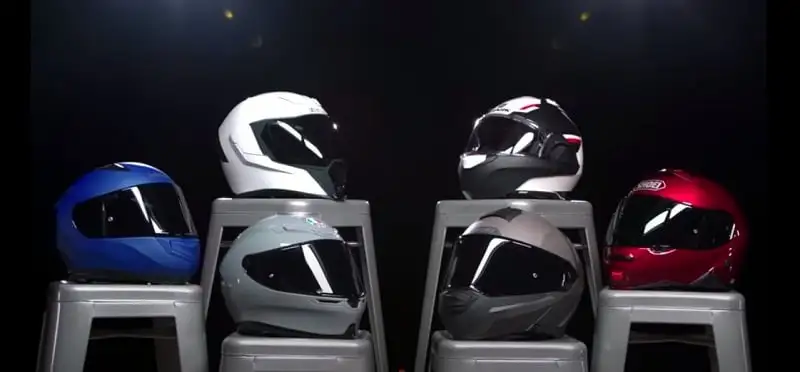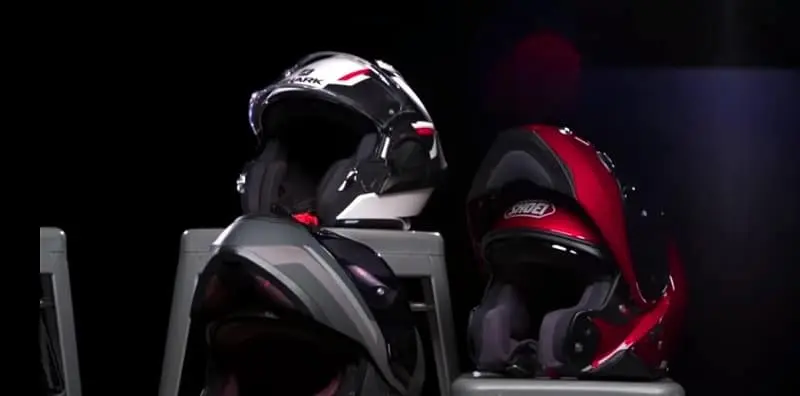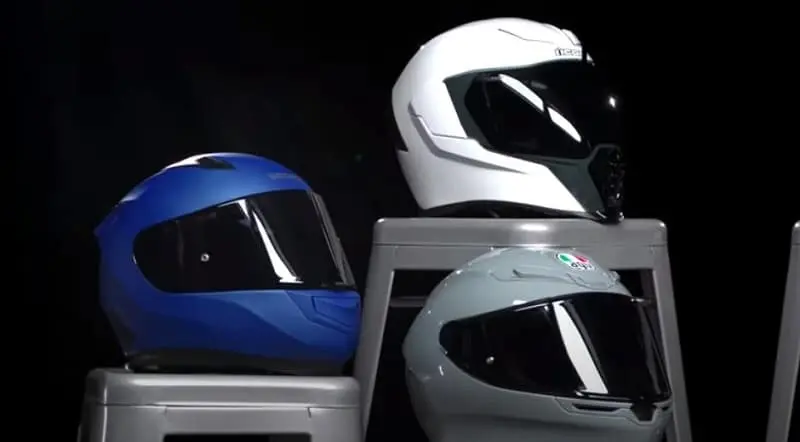Today we will discuss helmets, specifically full-face and modular/flip-up helmets.
The purpose of this article is not to tell you which one to use. Instead, I’m simply going to lay out the positives and negatives of each kind and let you make your own decision.
As we go through the comparison, I want you to keep an overarching question in mind: what is more important to you: safety and protection, or comfort and exposure?
Hopefully, this comparison will be helpful for beginners or anyone looking to see which one might be better for them.

Full-Face Helmets
Table of Contents
Unlike an open-face helmet, a full-face helmet is a single-shell construction that includes a chin bar and a sealable visor to cover your entire face.
Modular Helmets
And in the other corner, we have modular helmets. These cover your entire face as well, but modular helmets allow you to lift the front of the helmet open so you can eat your quarter-pounder on the go without taking your helmet off.
So we will examine these two options in various scenarios and discuss the pros and cons they bring to the table.
To do this, I’m going to take the most common questions we receive from customers and fellow riders like yourself, who come from various riding disciplines, climates, budgets; you name it.
Ultimately, we’ll better understand which option is right for your particular needs. So let’s get the ball rolling here with our first question.
Are Modular Helmets Louder Than Full-Faced?

First and foremost, noise is very subjective, meaning the idea of what’s loud will change from one rider to the next.
In addition, the rate of speed, the rider height, the materials being worn, the windscreen, etc., will affect how much wind noise is created.
That said, modular helmets tend to be a bit louder than most full-face helmets.
Unlike a full-face helmet, constructed from a solid shell, modular helmets have a hinge system to lift the chin bar.
The split design creates additional space between the chin bar and the shell.
A chin bar is prone to catching the wind as it moves over the helmet, contributing to higher noise levels.
Modular helmets are a bit larger than full-face lids because they need extra spacing for clearance to lift that big old chin bar up.
In addition, a larger shell will displace airflow, contributing to a louder helmet.
To combat this, the more premium modular helmet manufacturers usually add a lot of padding around the neck roll and cheek pads to help combat ambient noise, which will also help with stability.
There are quieter premium modular helmets on the market, but if you’re looking to prioritize a quiet helmet in your search, a full-face option is a way to go.
Is A Modular Helmet As Safe As A Full-Face?
First of all, yes, modular helmets are safe. All modular helmets will have to pass basic DOT safety standards for use in America, and a lot of options will carry the more advanced European ECE safety rating.
But are they safer than full-face helmets? Technically, no. A modular helmet has a separate chin bar that attaches to the main shell via two hinges and two locking pins.
To make a long story short, this rotating chin bar creates a weak point in the overall shell design, and there’s an increased risk of the hinge system opening during the strong impact of a crash.
This isn’t much of a concern compared to the full-face lid’s unified design.
Because of this, modular helmets haven’t been able to meet Snell’s increasing safety requirements for years. However, most full-face helmets without internal sun visors easily achieve that certification.
While modular helmets will provide the same level of protection in some crashes, they won’t necessarily provide the maximum level of safety in all crashes.
There’s a reason the fastest guys in the world are wearing a full-face helmet on the MotoGP grid.
If safety is your number one priority, a full-face helmet will be the ticket.
Are Modular Helmets Heavier Than Full-face helmets?

The weight of a helmet is something all riders should take into consideration. A heavy helmet can cause premature fatigue, especially for those logging some serious miles in the saddle.
On average, modulars are generally heavier than full-face helmets because they use a series of hinges, buttons, and locking pins, all the things we discussed earlier.
A modular’s overall shell size is typically larger than a full-face helmet to accommodate that extra hardware. Of course, larger means more material, which, in turn, typically means more weight.
It’s always important to specifically compare weights when choosing between two helmets if this is a consideration important to you.
But, in general, a similarly priced full-face helmet will weigh less than its modular counterpart.
So, if you know you’re logging some serious miles on the highway, a well-balanced, lightweight full-face might be the better option.
Do Modular Helmets Offer a Better Field Of Vision Than a Full-Face?
I think it’s important to note that while riders enjoy utilizing a modular helmet for its convenience, especially at rest stops, most modular helmets are not designed to be ridden with the chin bar in the open position.
There are a few outliers, like the Shark Evo line series, which has a chin bar that rotates up and towards the back of the helmet, which is a bit unique compared to a standard modular helmet.
At any rate, with the chin bar closed and secured while riding, the field of vision will be similar between the two varying types of helmets.
I know some advocates for three-quarter and half helmets critique the field of vision on full-face and modular helmets.
However, I can assure you that regardless of which one you’re using, you will have a full range of vision while safely riding down the road.
That’s why they have become a familiar favorite for touring riders and commuters alike.
In Conclusion
So what have we learned? First, if lower noise levels and improving safety in all riding conditions are a priority for you, full-face helmets will have the upper hand.
When it comes to something that offers the convenience of a three-quarter helmet at a rest stop while improving protection while riding, modular helmets are a great option for riders to look towards.
Hopefully, this article has given you a better idea of what makes the most sense when choosing your helmet.


